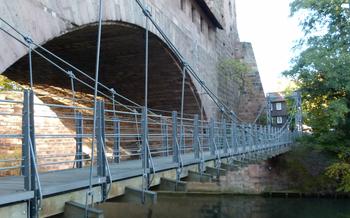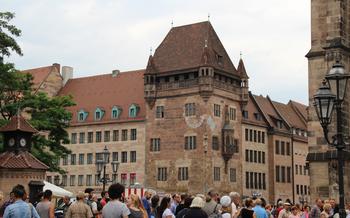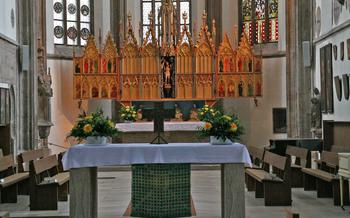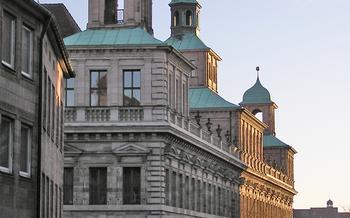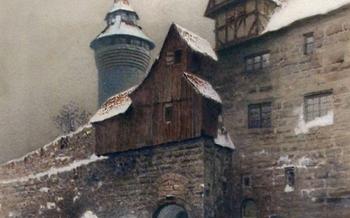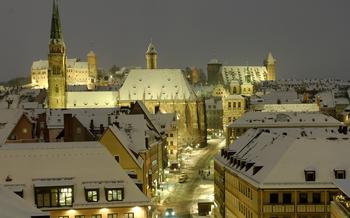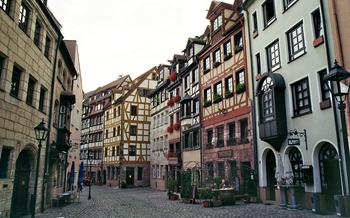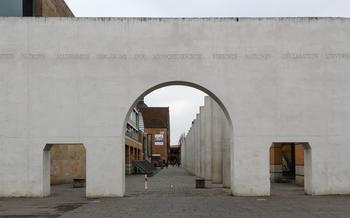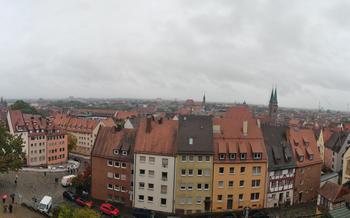
Museum for Communication Nuremberg
- Museum for Communication Nuremberg: A Journey Through the World of Communication
- Special Exhibitions and Events
- Guided Tours and Audio Guides
- Museum Shop and Cafe
- Educational Programs and Resources
- Exhibitions for Children
- Research and Publications
- Historical Significance of Nuremberg
- Transportation and Getting Around
- Accommodation and Dining Options
- Planning Your Visit
- Insider Tip: Unveiling the Secret Communication Bunker
Museum for Communication Nuremberg: A Journey Through the World of Communication
The Museum for Communication in Nuremberg, Germany, takes visitors on an immersive journey through the fascinating world of communication. Originally founded in 1925 as the German Postal Museum, it has evolved into a dynamic and multifaceted institution dedicated to exploring the history, technology, and cultural significance of communication.
Housed in a striking modern building with a glass facade, the museum seamlessly blends its historical heritage with contemporary design. Step inside, and you'll find an array of interactive exhibits, multimedia displays, and hands-on activities that bring the evolution of communication to life.
From the early days of letter writing and postal services to the digital revolution and the rise of social media, the museum offers a comprehensive exploration of how we communicate. Through interactive displays, you can experience the thrill of sending a telegram, learn about the inner workings of a telephone exchange, and even try your hand at Morse code.
Temporary exhibitions delve into specific aspects of communication, showcasing cutting-edge technologies and thought-provoking themes. Whether you're interested in the history of cryptography, the impact of social media on our lives, or the future of communication, you'll find something to captivate and inspire you at the Museum for Communication Nuremberg.
Special Exhibitions and Events
Beyond the permanent exhibitions, the Museum for Communication Nuremberg hosts a dynamic program of temporary exhibitions, workshops, seminars, and public events. These special offerings provide a fresh perspective on communication-related topics, showcasing cutting-edge technologies and thought-provoking themes.
Temporary exhibitions
The museum's temporary exhibitions are constantly evolving, offering visitors the chance to explore new and emerging areas of communication. These exhibitions often feature innovative technologies, interactive displays, and thought-provoking content that challenge visitors to think critically about the role of communication in society.
Workshops and seminars
The museum also hosts a variety of workshops and seminars that delve deeper into specific areas of communication. These educational programs are led by experts in the field and provide participants with the opportunity to learn from and engage with professionals from the world of communication.
Public events
Throughout the year, the museum organizes public events that bring together experts and enthusiasts to explore communication-related themes. These events may include film screenings, panel discussions, and workshops, offering visitors the chance to learn from and interact with thought leaders in the field.
Guided Tours and Audio Guides
Enhance your museum experience with guided tours led by knowledgeable experts who provide insights into the exhibits and share behind-the-scenes stories. These tours are an excellent way to delve deeper into the museum's collection and learn about the history and significance of communication technologies.
Guided Tours:
General Overview: Embark on a comprehensive guided tour that covers the museum's highlights, from the history of postal services to the evolution of telecommunications and digital media.
Thematic Tours: Choose from a range of thematic tours that focus on specific aspects of communication, such as the history of writing, the development of printing technologies, or the impact of social media.
Group Tours: Organize a guided tour for your group, whether it's a school class, a corporate team, or a family gathering, to ensure a personalized and engaging experience.
Advance Booking: Book your guided tour in advance to secure your spot, especially during peak seasons or for large groups. Check the museum's website or contact the information desk for availability and pricing.
Audio Guides:
Multiple Languages: Audio guides are available in multiple languages, allowing visitors from different countries to explore the exhibits in their preferred language.
Detailed Commentary: The audio guides provide detailed commentary on the exhibits, offering insights into their historical significance, technical details, and cultural impact.
Self-Paced Exploration: With audio guides, you can explore the museum at your own pace, pausing and rewinding as needed, and choosing the exhibits that interest you the most.
Accessibility: Audio guides are an excellent option for visitors with disabilities or those who prefer a more independent exploration of the museum.
Museum Shop and Cafe
After exploring the fascinating world of communication, take a break at the on-site cafe to rejuvenate with a variety of refreshments and light meals. The cafe provides a tranquil ambiance to reflect on your museum experience while enjoying a cup of coffee or a delicious snack.
The museum shop offers a treasure trove of communication-themed souvenirs, books, and gifts. Discover unique items inspired by the exhibits, allowing you to take a piece of the museum's history home with you. Whether you seek a commemorative gift for yourself or a thoughtful present for a loved one, the museum shop has something for everyone.
Educational Programs and Resources
Beyond its captivating exhibitions, the Museum for Communication Nuremberg offers a range of educational programs and resources that cater to diverse audiences. School groups can embark on interactive learning experiences tailored to their curriculum, engaging with the museum's exhibits through hands-on activities and guided discussions. Educators can access a wealth of online resources, including educational materials, virtual tours, and interactive games, allowing students to continue their exploration of communication beyond the museum walls.
Families are encouraged to participate in family-friendly events and workshops, where parents and children can explore communication together through creative activities and storytelling sessions. These programs foster intergenerational learning and create memorable experiences for the whole family.
The museum's research center plays a vital role in advancing the field of communication studies. Researchers conduct in-depth investigations into various aspects of communication, contributing to a deeper understanding of this multifaceted discipline. Their findings are disseminated through the museum's publications, including books, journals, and research papers, providing valuable insights to scholars, practitioners, and enthusiasts alike.
Exhibitions for Children
The Museum for Communication Nuremberg also caters to younger visitors with its dedicated children's exhibits. These exhibits are designed to make learning about communication fun and engaging for kids of all ages. Interactive activities, hands-on games, and age-appropriate content bring the world of communication to life for young minds. Children can explore the history of writing, discover the secrets of codes and ciphers, and even try their hand at creating their own communication devices.
The museum also hosts regular family-friendly events and workshops that encourage parents and children to explore communication together. These events may include storytelling sessions, creative workshops, and interactive demonstrations that make learning about communication a shared experience for the whole family.
Whether your child is fascinated by the history of communication or simply loves to play and learn, the Museum for Communication Nuremberg offers a stimulating and educational experience that will spark their curiosity and leave them with a lasting appreciation for the world of communication.
Research and Publications
The Museum for Communication Nuremberg is not only a place to explore the past and present of communication but also a hub for cutting-edge research. The museum's research center is dedicated to advancing knowledge and understanding in the field of communication through in-depth studies and collaborations with scholars from around the world.
Research Focus
The research center focuses on a wide range of topics related to communication, including:
-
The history of communication technologies: From the development of the printing press to the rise of the internet, the center explores how communication technologies have shaped societies throughout history.
-
The impact of communication on society: The center investigates how communication affects our culture, politics, and economy, examining the role of media and information in shaping public opinion and decision-making.
-
The future of communication: The center looks ahead to the future of communication, exploring emerging technologies and trends that are likely to have a significant impact on the way we communicate and interact.
Publications
The research center's findings are disseminated through a variety of publications, including:
-
Books: The center publishes scholarly books that provide in-depth analysis and insights into various aspects of communication.
-
Journals: The center publishes two academic journals, "Communication History" and "Communication Research," which showcase the latest research from around the world.
-
Research papers: The center's researchers regularly publish their findings in leading academic journals and conference proceedings.
Impact
The research conducted at the Museum for Communication Nuremberg has a significant impact on the field of communication. The museum's publications are widely read and cited by scholars and practitioners, and its research findings have been used to inform policy and decision-making at both the national and international levels.
Conclusion
The Museum for Communication Nuremberg is a world-renowned center for communication research. Its research center is dedicated to advancing knowledge and understanding in the field of communication, and its publications are widely read and cited by scholars and practitioners. The museum's research has a significant impact on the field of communication and helps to shape the way we think about and understand communication in the modern world.
Historical Significance of Nuremberg
Nuremberg, a city steeped in history, played a significant role as an imperial city of the Holy Roman Empire. It served as a thriving center of trade, culture, and politics, leaving an indelible mark on both regional and national history. Explore the majestic Nuremberg Castle, a symbol of imperial power, and delve into the captivating Albrecht Dürer House, where the renowned Renaissance artist once lived and worked. Immerse yourself in the rich collection of the German National Museum, showcasing the city's cultural heritage and artistic legacy.
Discover the profound impact of the Nuremberg Trials, a watershed moment in international law. Held in the aftermath of World War II, these trials brought Nazi war criminals to justice, setting a precedent for the prosecution of crimes against humanity. Nuremberg's role in this pivotal event underscores its enduring significance as a city that has grappled with its past and emerged as a beacon of justice and reconciliation.
Transportation and Getting Around
Nuremberg offers a comprehensive and efficient public transportation system that makes it easy to navigate the city and reach the Museum for Communication. The U-Bahn (metro) is a convenient option, with lines U1 and U2 connecting the museum to various parts of the city. Trams and buses are also widely available, providing access to the museum and other attractions.
For those who prefer to explore Nuremberg on foot, the city's pedestrian-friendly streets and well-maintained sidewalks make it a pleasure to walk around. The museum is situated within the historic city center, allowing visitors to combine their visit with a leisurely stroll through Nuremberg's charming streets and squares.
Additionally, Nuremberg is a bike-friendly city with designated bike lanes and paths. Visitors can rent bicycles from various locations and enjoy cycling through the city's parks and along the banks of the Pegnitz River. This is a great way to explore Nuremberg's green spaces and reach the museum while getting some exercise.
Whether you choose to use public transportation, walk, or bike, getting around Nuremberg is easy and convenient, ensuring that visitors can seamlessly integrate their visit to the Museum for Communication with other activities and attractions in the city.
Accommodation and Dining Options
Nuremberg offers a wide range of accommodation options to suit every budget and preference. From charming guesthouses nestled in the historic Old Town to modern chain hotels with convenient amenities, there is something for every traveler. Many hotels are located within walking distance of the Museum for Communication, making it easy to explore the museum and other nearby attractions.
For those seeking a unique and authentic experience, consider staying in a traditional Bavarian guesthouse. These guesthouses often offer cozy rooms with wooden furnishings and traditional Bavarian decor. Some guesthouses also have their own restaurants, serving hearty Bavarian cuisine and local beers.
If you prefer the convenience of a modern hotel, Nuremberg has plenty of options to choose from. Many international hotel chains have a presence in the city, offering comfortable rooms and amenities such as fitness centers and business centers. These hotels are often located near the main train station or in the city center, making it easy to get around.
Nuremberg's culinary scene is as diverse as its accommodation options. From traditional Bavarian cuisine to international flavors, there is something to satisfy every palate. Be sure to try some of the local specialties, such as Nuremberg Rostbratwürste (grilled sausages) and Lebkuchen (gingerbread).
For a taste of traditional Bavarian cuisine, head to one of the many restaurants in the Old Town. These restaurants often have cozy interiors with wooden paneling and traditional Bavarian decor. The menu typically features hearty dishes such as Schweinshaxe (roasted pork knuckle) and Käsespätzle (cheese noodles).
If you are looking for something a little different, Nuremberg has a number of international restaurants to choose from. You can find everything from Italian and Greek to Asian and Mexican cuisine. Many of these restaurants are located in the city center or near the main train station.
No matter where you choose to stay or eat in Nuremberg, you are sure to have a memorable experience. The city offers a wide range of options to suit every taste and budget, making it a great destination for a weekend getaway or a longer vacation.
Planning Your Visit
Whether you're a history buff, a tech enthusiast, or simply looking for a fun and educational experience, the Museum for Communication Nuremberg offers something for everyone. To make the most of your visit, consider the following tips:
-
Itinerary suggestions: With limited time, prioritize the exhibits that align with your interests. If you have more time, explore the museum's diverse offerings at a leisurely pace.
-
Tips for saving money: Take advantage of discounts for students, seniors, and families. Consider purchasing a Nuremberg Card, which offers free admission to the museum and other attractions, as well as unlimited use of public transportation.
-
Hidden gem: Explore the museum's rooftop terrace for panoramic views of Nuremberg's historic city center and surrounding landscapes.
Insider Tip: Unveiling the Secret Communication Bunker
Venture beyond the museum's walls to discover a hidden gem that lies just a short distance away: the Communication Bunker. This Cold War-era bunker, once a top-secret facility, served as a vital communication hub during times of crisis. Today, it stands as a testament to Nuremberg's role in global communications.
Explore the bunker's intricate network of rooms, each equipped with vintage communication equipment, including teleprinters, radios, and switchboards. Learn about the bunker's crucial role in maintaining communication during the Cold War and its continued significance as a historical site.
Guided tours are available, providing a unique opportunity to delve into the bunker's history and witness its preserved equipment firsthand. Immerse yourself in the atmosphere of this hidden gem and gain a deeper understanding of the vital role communication played during this tumultuous period.
